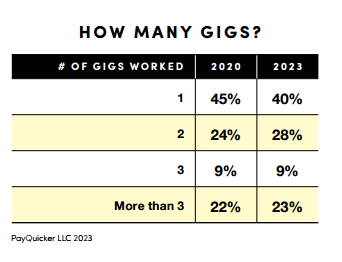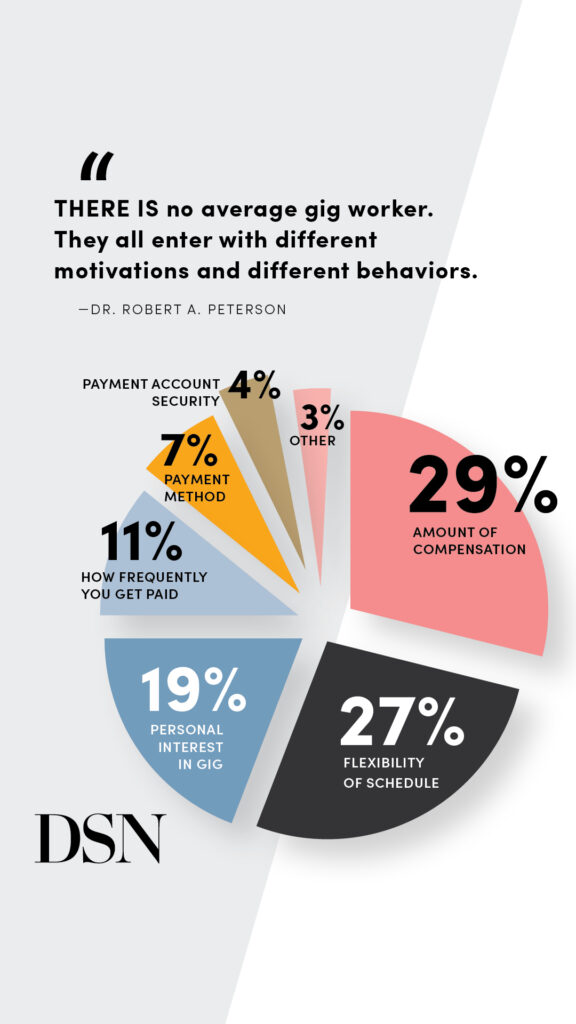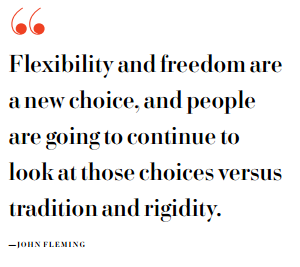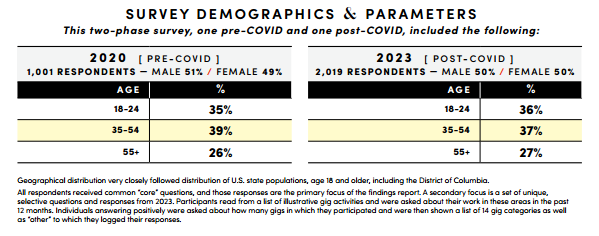Unpacking the future of work / insights into the gig economy workforce
Jazz era musicians may have coined the phrase “gig” when they raised their instruments at speakeasies, but getting paid on a per-job basis for part-time work wasn’t new then, and it isn’t new now.
The laundress who took in wash over a century ago. The kid mowing yards all summer. The freelance consultant doing taxes on the side. The temp employee filling a short-term manufacturing job—it’s all gig work.

Gig work quietly churned as barely decipherable economic white noise for decades. Its financial impact for workers was real and put food on the table and plumped rainy day savings. But it took technology—specifically the internet—to supercharge, modernize and legitimize gig work, ultimately creating the gig economy.
Early internet-based, tech-platform driven companies like Uber and Lyft, that disrupted the traditional transportation model by engaging people from all walks of life and enticing them to earn money using underutilized assets they already owned, sparked a phenomenon that’s grown to engage 60 million people.
To get here, modern gig workers transported not only people, but dinner, groceries and whatever else they needed from a retail store to their home. The COVID-19 pandemic shut things down; workplace behavior and locations changed; and the population grew increasingly mobile—all of which catapulted the popularity of gig work.
Today, the gig economy is an umbrella term broken into subsets like “sharing economy,” “on-demand economy” and “platform economy.” It’s a channel mechanism that effectively and efficiently links gig workers and customers.
And it is BIG! It’s economic estimate is $1 trillion annually in the U.S. with an average growth rate of 16-17 percent (aggregated consensus from multiple sources). Projections say 100 million gig workers will pursue primarily part-time income using pay-for-performance criteria by 2027.
But to be clear, gig workers certainly aren’t just shuttling people to the airport or delivering dinner any longer. They likely never were.
“The gig economy is very broad, and that’s one of the reasons why we feel it behooves study. Because sometimes we think we understand, but there’s so much more to it,” John Fleming, long-time advocate of the direct selling industry, author and founder of the Ultimate Gig Project, shared.
Fleming and Dr. Robert A. Peterson, a former Vice President of The University of Texas at Austin, who holds the John T. Stuart III Centennial Chair in Business Administration and served on an advisory committee to the U.S. Census Bureau, set out to uncover more about the gig economy. Their efforts, The Future of Work: Insights Into the 2023 Gig Economy Workforce, are available now.
Who is in the Gig Economy. And Why.

Two surveys of self-identified gig workers—conducted by the Ultimate Gig Project, the first in 2020, pre-pandemic with 1,001 respondents and the second, post-pandemic in 2023 with 2,019—offer insight into the worker pool’s diversity; the work they perform; and their earnings expectations and spending habits. Linear trends have emerged showing the diverse nature and rapid growth of the gig economy itself, which have major implications for business, government and society.
This is the only known gig worker study—stretching beyond very defined subsets, like Uber, Lyft or 1099 workers—to include multiple categories within the gig economy. Additional surveys are expected in late 2024.
“When we do research, we are not trying to provide answers as much as we are attempting to stimulate thinking,” Fleming explained. And The Future of Work: Insights into the 2023 Gig Economy Workforce gives the direct selling industry a great deal to mull over.
So, who are the gig workers leading this gig economy? What do they do and what do they want? And how might direct selling best capitalize on this phenomenon?
“There is no average gig worker. People talk about the economy. Yes, it’s out there. It’s a trillion dollars. Yes, we’ve got 60 million people, but there’s no average gig worker. They all enter with different motivations and different behaviors, so there are different subsets. They’re in there for different reasons,” Dr. Peterson said.
The youngest gig workers, 18-34, are doing deliveries, earning extra spending money. Household bills may not be a priority for their paychecks. But those midlife gig workers, 35-54, now rely on gig work to meet household bills. And that’s a definite change since 2020, when most gig workers socked earnings away for retirement, savings or investments. The over-55 group tends to like their gig—so they stay with it. For them, it may be less about the money and more about staying active.
Gig workers report satisfaction with the flexibility and freedom associated with the work as well as the pay, reporting that earnings exceeded their expectations upon entering the workforce. And they tend to stick around, too.
The starkest change between 2020 and 2023 was in the number of gigs in which these workers participate. One was enough three years ago, but today it’s common for people to participate in multiple side hustles, while maintaining a similar number of work hours. Food delivery gigs have nearly doubled. This indicates a change in the structure of the gig economy, as well as an opportunistic work force. The norm is now three or more gigs.

Sixty percent of people now work multiple gigs, which Fleming said is likely the result of a couple things: mastering the work and wanting more of it or branching out to similar work because they have flexibility and freedom.
While gig economy predictions get dicey, today’s reality is that people continue to join its ranks. But Dr. Peterson warns that current growth rates cannot go on forever.
“Just mathematically, as it grows bigger, it’s got to also grow slower. Because there’s a limit in terms of the number of people that are out there in the population. So, if you look at a cap of 100 million people as potential gig workers (2027 projection), that might be it. And when we get to that, we’ll see a plateauing in terms of growth.”
Capitalizing on the Gig Work Phenomenon
This seems to indicate a timeliness factor associated with how best to utilize gig workforce data within the business world and inside the direct selling industry.
“Choice is prevalent, and there are so many choices out there. It’s one of the things that we should pay attention to because the traditional, industrial-economy work ethic has changed, and employers are finding it more and more difficult to get people into a nine-to-five job. Flexibility and freedom are new choices, and people are going to continue to look at those choices,” Fleming explained. “Direct selling practitioners really need to pay attention to that because it might lead to redefining how and what we offer.”
For years, the direct selling industry has watched the gig phenomenon grow, believing that direct selling was something more than a gig—which it arguably is. But misunderstandings about the breadth and depth of the gig economy may have stopped direct selling’s decision makers from fully capitalizing on the gig work phenomenon. After all, today’s gig worker, as defined by this new research, could be direct selling’s newest prospect.

In the 2020 survey, six percent of self-identified gig workers declared themselves to be direct sellers. That number is now down to three percent. Why?
“From our point of view, direct selling is a subset of the gig economy. So, it’s not a matter of should direct sellers become gig workers? They are gig workers. If you look at the broader definition, the gig economy includes independent contractors in many different formats. But sometimes we narrow that definition too much in accordance with our own perception,” Fleming said.
Direct selling’s biggest challenge may be in positioning itself as more relevant in the marketplace. The industry offers extraordinary products and services, but relevance is also about perception. And that, Fleming believes, is the industry’s big opportunity.
Firms like Upwork are growing because people from all walks of life are looking to be in more control of their work. That mirrors direct selling. But would these Upwork gig workers—who prioritize flexibility and freedom—really respond to “career” pitch messaging? Do self-defined gig workers want a “career”? Could direct selling’s “career” messaging need an update to attract a new kind of prospect?
Relevancy. Fulfillment. Perception.
The gig economy has all but ignored career earnings talk. Yet it has given people who want to put in more time the ability to earn more. The satisfaction rate is high among gig workers. People love what they do and there is no over promise.
Less than 10 percent of gig workers are interested in career-type incomes, which start roughly at $2,000/month. A great percentage are satisfied with $300, $400 or $500 per month, so long as they are able to work when and how they want.

And with technology making it much easier for people to do so many things in the gig economy, why shouldn’t direct selling be one of those gigs? Could it be time to shake out the complexities and multiple gig restrictions in direct selling and simplify?
“If we believe we’re that good—and I certainly think we are—then perhaps we need to look at repositioning our proposition—maybe speaking a little differently about who we are and what we do as well as taking steps to eliminate the adversarial attitudes that many segments have for the way we conduct business,” Fleming said. “The gig economy doesn’t make promises. They basically offer you a possibility, and then you become engaged. Then they reward you on performance. It’s really up to you. If you do the work, you’re going to get paid. And this gig economy has triggered how we think about all forms of work.”
And it’s that type of wide-spread disruption that creates opportunity for the direct selling industry. Direct sellers could argue that they were the first gig workers. On paper, the “why”s of so many direct sellers—flexibility, time freedom, earnings potential—read like a gig work must-have list.
To be the best at customer acquisition and retention in a marketplace that demands it, yet failing to compellingly convey that story—when there’s so much potential—is a contradiction and challenge worth exploring. If direct selling, as a subset of the gig economy, can simplify and easily show gig prospects the aggregate benefits from the customers they help influence and acquire who then continue to purchase the products, it can only gain ground.
“We have so much room to improve and position ourselves, so the public—the marketplace if you will—can better understand who we are; what we do and how much we have to offer,” Fleming said.
Defining the Gig Economy and Its Participants
Growing four times faster than the traditional economy, gig work and gig workers are evolving. The desire for flexibility and freedom is strong and new research indicates the only real commonality is the need for more money.
The Future of Work: Insights into the 2023 Gig Economy Workforce provides a glimpse at a diverse and ever-changing worker group. Here are some key points to ponder from that recently published research.
- No specific gig activity dominates the gig economy. Fewer than 1-in-12 pursued a platform-based ride sharing gig in 2023.
- Online platform-based gigs are just one segment, despite attracting the majority of media attention.
- Female gig workers expect to earn less than their male counterparts (and do). The underlying reasons are numerous, complex and explainable.
- Despite the need for more money, a not insignificant proportion of the gig workforce engages for reasons not associated with pay.
- There is little distinction between primary and secondary gigs for those who pursue multiple gigs in terms of the nature of the gig, time spent or earnings received.
Want to learn more? View the full report, sponsored by PayQuicker.

What You Should Be Asking Yourself and Your Team
1/ What does work look like in the future? Flexibility and freedom have a lot to do with how people want to live and relate to their families. How might direct selling better meet societal expectations and change?
2/ The gig economy is a phenomenon that doubled between 2018 and 2023. Why has the gig economy outpaced direct selling since 2015?
3/ Gig workers are average Americans. Who they are; how they participate; how many gigs they work; their earnings expectations; and how they spend their money can influence how direct selling companies recruit them. Should direct selling modify its messaging? If so, how?
4/ Why do 60 percent of gig workers participate in multiple gigs? They pursue flexibility, freedom, work/life balance and earnings to meet household expenses. Can direct selling help meet their needs?
5/ Direct selling is a subset of the gig economy but captures only three percent market share. How might direct selling improve and position itself to gain market share? Is it worth it? Can direct selling simultaneously offer gig work and a career opportunity?
From the September 2023 issue of Direct Selling News magazine.


